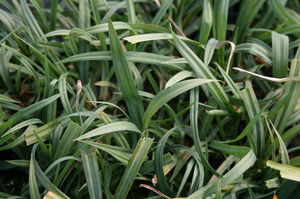Printed at http://www.newmoonnursery.com/index.cfm/

A good liriope replacement, blue wood sedge is best for moist areas, such as stream and pond margins.
Carex flaccosperma
Blue wood sedge
Native to North America
FIRST IMPRESSIONS: Carex flaccosperma is a petite perennial sedge that forms attractive slowly spreading clumps. The narrow leaves are a striking blue-green and are often evergreen. In late spring greenish scaly flower spikes are displayed above and beyond the foliage. Interesting brown seed spikes follow. This sedge occurs in wet woods or can be planted in moist or wet shade gardens.
HABITAT & HARDINESS: Carex flaccosperma is native from New Jersey south to the Florida panhandle and west to Illinois, Missouri, Arkansas and east Texas.
Plants are indigenous to moist meadows, low rich woodlands, flood plains, margins of swamps and open disturbed sites.
Hardy from USDA Zones 5-8.
PLANT DESCRIPTION: Carex flaccosperma grows in compact clumps of arching bluish foliage. Plants gradually form small colonies from short underground rhizomes.
Foliage is glaucous and blue, blue-green or medium green. Leaves are generally 6-12” and about 1/2” wide. Blades have an almost quilted appearance due to the prominent parallel veins and are evergreen through most of the range.
In spring culms bear terminal staminate (male) spikes with purplish or brownish scales. The pistillate (female) spikes below have pale green or reddish scales and an abundance of large oblong perigynia. The perigynium is a sac that encloses the pistillate flower and later the seed. As seed matures the perigynia turn a golden brown color.
This sedge is up to 1’ tall with a 1’ spread.
CULTURAL & MAINTENANCE NEEDS: Carex flaccosperma prospers in moist woodland gardens with bright shade. This sedge can also take some sun but only if planted in rich moist soil. In sun may tend to be lanky.
Plants are not finicky about soil and are tolerant of average soils, wet sites and clay.
Established plants are drought tolerant, pest resistant and unpalatable to deer and other herbivores. A limited number of seedlings are produced but this is not an invasive sedge.
In garden situations, plants should be cut to the ground during late winter before new growth is initiated.
LANDSCAPE USES: Carex flaccosperma is a valuable Groundcover or Edging Plant for a Shade Garden. This sedge is useful in meadows and is lovely when Grouped or Massed in wet areas beside a stream or pond. The unique leaf color allows this sedge to serve as an eye catching Accent, Grouping or Mass Planting. Plants provide Erosion Control and Winter Interest and are appropriate for Deer Resistant Plantings, Low Maintenance Plantings, Rain Gardens, Rock Gardens and Wildlife Gardens.
Carex flaccosperma is a great native substitute for the popular Asian groundcovers Liriope muscari and Ophiopogon japonicus.
COMPANION & UNDERSTUDY PLANTS: Suitable garden companions for Carex flaccosperma could include: Heuchera americana ‘Dale’s Strain’, Iris cristata, Phlox divaricate, Viola walteri ‘Silver Gem’, Spigelia marilandica, and Polystichum acrostichoides.
Carex laxiculmis is similar in appearance but requires a consistently moist or wet site without episodes of drought.
TRIVIA: Carex flaccosperma is similar in appearance to C. laxiculmis. Some differences between the two are that C. flaccosperma will tolerate some drought and has up to 60 beakless perigynia per spike. C. laxiculmis, on the other hand, requires moisture and each pistillate spike has 4-9 perigynia with bent tapering beaks.
Height:
1 ftSpread:
1 ftSpacing:
18-24 inUSDA Hardiness Zone:
5-8Bloom Color:
BlueCarex flaccosperma Characteristics
Attracts Wildlife
- Pollinators
Attributes
- Naturalizing
- Rain Garden
- Ground Cover
- East-Coast Native
- Clay Soil
- Bog
Exposure
- Full Sun to Full Shade
Deer Resistant
- Deer Resistant
Flowering Months
- June
Foliage Color
- Blue
Grass Season
- Cool Season Grass
Groundcover Foot-Traffic Tolerances
- Light
Lawn Replacement or Groundcover
- Groundcover
Soil Moisture Preference
- Moist to Wet
Interesting Notes:
For more information on this plant, visit the USDA PLANTS Database: http://plants.usda.gov/java/profile?symbol=CAFL3
